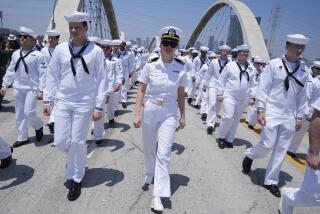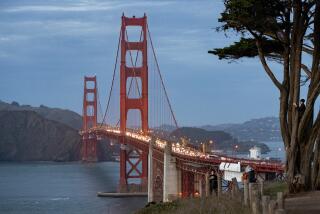Celebrants Test Design of Golden Gate Bridge
SAN FRANCISCO — The load capacity of the Golden Gate Bridge, designed 50 years ago by forward-looking engineers, never was threatened by the hordes who jammed its deck during a weekend anniversary celebration, the bridge district’s chief engineer said.
“The load we had out there doesn’t come close to the design load of the bridge,” Dan Mohn said, adding that the bridge was designed “to carry the heaviest trucks of the time the full length of the bridge in high winds and during an earthquake.”
Mohn said the 250,000 people who packed the bridge Sunday for the 50th anniversary celebration made up the heaviest load ever supported by the orange landmark, heavy enough to temporarily flatten out the arch of the bridge deck and to concern some bridge officials.
The concerns led Mohn to do some rapid calculations during the bash to see how close the weight came to the capacity designed by Joseph Strauss and others 50 years ago.
The designers built the bridge to support 7,700 pounds per linear foot during a combination of high winds and earthquake, Mohn said. He said his calculations showed that Sunday’s load reached about 5,400 pounds per linear foot where the crowd was thickest.
Some celebrators suffered motion sickness as the bridge swayed in the 40-m.p.h. wind that howled through the Golden Gate, the mile-wide channel joining the Pacific and San Francisco Bay. The bridge is built to flex as far as 27 feet side to side.
“The public demonstrated that the bridge is a live animal and is constantly moving,” he said. “When you’re driving across in your car, you really don’t feel the movement that we bridge workers feel when we’re out there working on it.”
Bridge District President Gary Giacomini said Monday that while he regretted that more than 500,000 were turned away without ever reaching the bridge deck, he was glad they did not make it because “maybe the bridge would have fallen down.”
But Mohn said Giacomini should not have worried.
“There is no way to put enough people on that bridge to cause any structural failure,” he said. “You’d have to stack them three high, and even that wouldn’t do it.”
More to Read
Sign up for Essential California
The most important California stories and recommendations in your inbox every morning.
You may occasionally receive promotional content from the Los Angeles Times.










